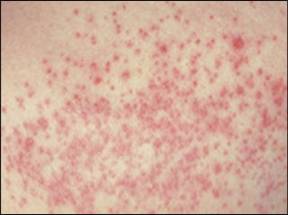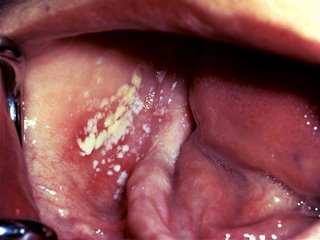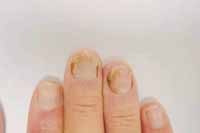Monday, September 04, 2006
Topical Candida Rash Cure
Here's an interesting tip I learned today, to get rid of itchy rashes such as jock itch, diaper rash, or candida rashes, just apply a bit of listerine to the area. This mouthwash contains 29.6% alcohol, eucalyptus oils, menthol, methyl salicylate and thymol. All of these are powerful antifungals, and even more so when they are used together.
Wednesday, August 30, 2006
Yeast Infection Pictures
Sure there are descriptions of what yeast infections look and feel like, but what exactly does thrush look like? Here are some yeast infection pictures to help you better diagnose if you do indeed have a candida outbreak.
Skin Rash: Clusters of red dots
Oral Thrush: Candida infection of the inner cheeks
Yeast Infection: Infected nails become yellow and will detach from the nail bed.
Technorati Tags: yeast infection pictures, candida albicans, thrush, yeast infection, candiasis, rash
Tuesday, August 08, 2006
Natural Candiasis Cure - Oil of Oregano
Uses of oil of oregano
The health benefits of oil of oregano are numerous. Oil of oregano has long been used as an alternative treatment and cure of fungal and yeast infections. This supplement is often taken internally for Candida albicans overgrowth of the intestines, leaky gut syndrome, or oral thrush. It can be applied topically in diluted form to treat rashes, jock itch, and vaginal yeast infections.
Where does oil of oregano come from?
Oregano is an herb that is found in wilds of Mediterranean regions such as Greece. Today oregano is cultivated worldwide. Oregano is an aromatic herb that can grow to about two feet in height. The leaves and dried herb as well as the volatile oil of the oregano plant are used medicinally.
What gives oil of oregano its medicinal properties?
Oil of oregano contains several powerful compounds including carvacrol, thymol, and borneol, flavonoids, rosmarinic acid, triterpenoids (e.g. ursolic and oleanolic acid), sterols, and vitamin A and vitamin C. The thymol and carvacrol in oil of oregano are antimicrobials and antifungals. Studies have demonstrated that oil of oregano, and carvacrol in particular, inhibited the growth of Candida albicans.
In addition to its anti-fungal properties, and according to the results of another study from Australia, oil of oregano has a strong anti-microbial action against a wide number of bacteria, including E. coli, Klebsiella pneumoniae, Salmonella enterica, and Staphylococcus aureus. Studies have also shown that oil of oregano from Mexican species of the herb are more effective than the prescription medication tinidazol in inhibiting certain parasites such as Giardia duodenalis).
Technorati Tags: oil of oregano, alternative treatment, natural cures, remedies, yeast infection, candiasis
Monday, August 07, 2006
Olive leaf extract - a natural cure for a yeast infection or thrush
An abundance of scientific information is coming out with evidence of the healing power of plants. Nature has already provided us with many compounds that fight cancer or protect us from harmful micro organisms. These natural compounds are found in fruits, vegetables, leaves, stems, and roots. They are called a variety of names such as polyphenols, flavonoids, pycnogenols, glucosinolates, isoprenoids, carotenoids, flavonols, tocotirenols, and proanthocyanadins.
One such compound is oleuropein which is found in the olive leaf. The olive leaf has a long history in the western world. It is the first plant mentioned in the Bible, regarded as a symbol of heavenly power by the Egyptians, and has been used as a popular folk remedy for curing feavers. It was even successfully used to cure fever and malaria about 150 years ago. Daniel Hanbury who discovered the healing recipe conjectured that the healing powers of the olive leaf were due to a bitter substance in the leaves. That substance is now called oleuropein which is produced naturally by the olive plant to fight insect and bacterial damage. This substance is present in olive oil, and all olive products. However, oleuropein is removed from olives when they are cured.
In the 1960s researchers discovered that oleuropein lowered blood pressure, increased blood flow in the coronary arteries, relieved arrhythmias, and prevented intestinal muscle spasms. It was also discovered at this time that oleuropein is a powerful antifungal and antibacterial and an extremely strong antiviral. Olive leaf extract can be used internally or applied topically to cure a yeast infection or thrush.
Olive leaf extract is sold in caplet form and tinctures. Since this is a bitter tasting compound, many people tend to prefer taking the extract in caplet form. However, if you wish to use olive leaf extract as a topical application for thrush or a rash, you'll want to get a tincture.
Technorati Tags: olive leaf extract, yeast infection, thrush, natural cure, remedy, treatment, candida albicans, phytochemicals, supplements, healing plants, botanicals
Friday, August 04, 2006
Why is Candida albicans resistant to antifungals?
The treatment of Candida albicans is becoming more of a struggle as resistance to the limited number of antifungal drugs increases. Studies at the University of Minnesota have found that a certain chromosomal state, anneuploidy and an isochormosome, were responsible for resistance to azoles, important ingredients in antifungals.
Aneuploidy and Isochromosome Formation in Drug-Resistant Candida albicans
Technorati Tags: candida albicans, yeast infections, resistance, antifungal
Thursday, August 03, 2006
Skin discoloration caused by yeast?
A problem that's exacerbated by tanning during the summer, white spots on skin can be caused by a type of yeast called tinea versicolor. Unlike other tinea molds that cause jock itch, athlete's foot, and ringworm, the yeasts are not contagious. The yeast doesn't actually cause the skin to be lighter, it just blocks the areas where they live from absorbing light and tanning. Those with oily, damp, or irritated skin are especially susceptible to versicolor yeasts.
During the winter, when skin becomes untanned, the spots can look darker than the surrounding skin or even red. The spots often appear in clusters of white dots. To treat this type of yeast infection you should use a cream for the treatment of athlete's foot or jock itch such as Lotrimin or Tinactin and apply twice daily to the affected area. Another possible treatment is to use a shampoo containing selenium such as Selsun Blue or Head and Shoulders. Of course you should always try natural remedies for curing yeast infections such as those posted earlier here at Yeast Infection Symptoms and Treatments.
Technorati Tags: yeast infection, tinea, candida, natural cures, treatment, remedy
Tuesday, August 01, 2006
A yeast infection keeps coming back, what should I do?
Chronic yeast infections are the pits. You're not on antibiotics, have a healthy diet and lifestyle, and you don't have a weakened immune system. You may have even been tested for STD's and all your results came back negative. So what's causing this?
- If symptoms start appearing every month before your period, your natural hormone fluctuations could be the cause of your sensitivity to infections. Combat this by eating probiotic products like yogurt with live active cultures of Lactobacillus acidophilus, acidophilus supplements, or kefir. You'll also want to cut down on the amount of sugars and starches you consume. Try natural sweetners like stevia instead.
- If you're sexually active, then you and your partner may be passing the infection back and forth. Sometimes yeast infections in men don't show any outward symptoms, othertimes there may be itching and discharge. In any case you'll both want to see a doctor about this to make sure you aren't infecting each other.
- How do you wash your underwear? I know this is weird, but yeast from discharge could live and breed in the fabrics of your clothes. You'll want to wash your underwear with hot water (on an extra long cycle) after a yeast infection. And this is obvious to most people, but change your underwear everyday!
- Again, if you're sexually active, then some condoms may trigger a yeast infection. Condoms with the spermicide nonoxynol-9 may be irritating and it definitely upsets the pH of your system down there. Look for condoms that don't have nonoxynol-9, or use other forms of barrier protection. You may also be getting yeast infections if you're allergic to latex, try using plastic polyurethane condoms.
Technorati Tags: chronic, yeast infection, symptoms, recurring, cures, treatment, natural, remedies
Monday, July 31, 2006
Why are pregnant women more likely to get a yeast infection?
During pregnancy, women's bodies produce increased amounts of estrogen. The excess estrogen production also triggers an increase in production of glycogen in the vagina. Glycogen is a type of sugar and as we've discussed in previous posts, yeasts thrive on sugar! This in turn causes an imbalance in the number of yeasts in the vagina, also known as a yeast infection.
Treatment options recommended by physicians during pregnancy include only vaginal creams and suppositories. Diflucan and other oral medications have not been proven safe to use during pregnancy and lactation. Do not let a yeast infection go untreated! The yeast infection can pass to the baby's mouth during delivery, causing oral thrush which will have to be treated wih Nystatin.
Treatment may take as long as 10 to 14 days, but once the infection has cleared and any sores have disappeared, you may want to use a starch free drying powder to eliminate any excess moisture. This will help prevent a recurring infection. There are other pregnancy safe treatment options to prevent recurring yeast infections.
- Wear loose breathable clothing. Your clothing and underwear should preferably be cotton.
- Use a blow dryer on low/cool after showering to help dry your genital area.
- Always wipe front to back after using the bathroom.
- Shower immediately after swimming or working out. Change out of swimsuits and workout clothes as soon as possible.
- Don't use feminine hygiene products that contain deodorants, soaps, colors, or perfumes.
- Include probiotics in your everyday diet.
- Limit your consumption of sugar and starches.
- Get plenty of rest and stress relief to boost your body's immune system.
Technorati Tags: yeast infection, pregnancy, treatment, cure, symptoms, natural
Saturday, July 29, 2006
Bacterial Vaginosis - the look alike condition
Those Hard-to-Clean Places
I have always been someone who had the occasional yeast infection
and, once in a while, bacterial vaginosis (BV). I get that I have a
pussy and every once in a while it goes a little off. But now I seem to
have BV perpetually, and I have a few friends who suffer from the same
problem, even with prescribed treatment. I was wondering if this
bacteria has just foiled all medications and now it's time to try a new
course of action. Diet? Anything? Help! BARBARA VACARRO VAGINA
Michelle Bodner, the naturopath I often consult, confirmed the
possibility of the hypothesis that your BV may be resistant to a
prescribed antibiotic, but added this: "It may also be that it's not BV
at all, but a recurrent yeast infection caused by a non-albicans
species of yeast. There are limited anti-fungal treatments available
and most only treat albicans species. The best solution is to look at
the underlying problem, starting with a proper diagnosis."
A friend who was dealing with hellishly persistent BV for
months has managed to clear it with naturopathic solutions, something
that Dr. Bodner also suggests as an appropriate route: "Treat the
infection naturally, improve vaginal pH and flora balance and support
the immune system. Your partner, male or female, should be treated as
well, as it is possible for either yeast or BV to be transmitted
sexually."
Eye Weekly
Technorati Tags: bacterial vaginosis, candida, yeast infection, albicans, candida
Thursday, July 27, 2006
New Drug-Free Treatment for Disease Often Works Where Nothing Else Will: From Yeast Infections to Cancer (press release)
Gary Craig, the Stanford-trained engineer who developed EFT (Emotional Freedom Techniques), announces that the procedure has helped patients recover from chronic yeast infections without drugs or adverse side effects, as reported by medical doctors and their patients.
The claim is impressive, considering that 35 percent of American women using birth control pills have chronic vaginal yeast infections, and in men, jock itch and athlete’s foot are common. All three conditions are linked to Candida albicans, a naturally occurring yeast that creates problems when it grows out of control. In children, especially those who have been on antibiotics, Candida can cause thrush, a throat infection. Even the family dog’s chronic ear infections are linked to Candida.
Conventional medicine treats yeast and fungal infections with symptom-suppressing drugs, but these drugs can have side effects, and the condition often recurs.
Raul Vergini, MD, appreciates how difficult it is to eliminate candidiasis. When one of his patients couldn’t get rid of the condition he applied EFT. Modeled after acupuncture, EFT uses gentle fingertip tapping to release blocked energy along with stored emotions that contribute to health problems. Dr. Vergini tapped with the patient as they focused on her symptoms.
Two days later, her persistent itching, burning, discharge, and inflamed irritation had disappeared. A follow-up exam showed her to be clinically free from Candida. “She was also able to easily control, with EFT, the burning stomach pain she experienced every evening after dinner, especially when lying down,” Dr. Vergini says.
Los Angeles urologist Eric Robins, MD, blames unresolved emotional issues for 85 percent of all illnesses, especially chronic conditions that don’t respond to conventional therapy. “Some day,” he says, “modern medicine will realize this, and EFT will become a primary healing tool for physicians everywhere. It already is for me.”
Over 225,000 worldwide, including many health care practitioners, have downloaded Craig’s free EFT training manual from the official EFT website, which features reports and case studies on hundreds of illnesses, including cancer. The manual provides all the basics so that anyone can begin using it immediately.
News Target
Technorati Tags: yeast infection, treatment, cures, remedy, alternative, natural
Yeast Infection Cures
Here are the best natural home remedies for yeast infections.
- Vinegar
- Drink 2 tbsp of apple cider vinegar in water three times a day until the infection clears.
- Douche with a dilute vinegar solution two times a day until the infection is gone.
- Probiotics
- Take acidophilus tablets which are readily available at any pharmacy.
- Use plain yogurt with live active cultures on the site of infection. For vaginal yeast infections, dip a tampon into the yogurt and insert the tampon for about half an hour.
- Eat plenty of yogurt with live active cultures or kefir.
- Pure unsweetened cranberry juice
- Make boric acid suppositories with boric acid solution and gel caps from your local pharmacy. This cure is also effective for bacterial vaginosis. Insert one suppository every night for two weeks.
- Garlic
- Eat lots of garlic.
- If you're adventurous, try inserting a clove of garlic for about 30 minutes once a day until the infection clears. You can also just rub garlic on other infected areas.
- Vitamin B3, also known as Niacinamide is toxic to yeast! Take 100 to 500 mg each day until the infection subsides. You can also apply niacinamide topically to rash or itchy areas.
Technorati Tags: yeast infection, cures, remedies, treatments, natural, symptoms, homemade, candida, candiasis
- Drink 2 tbsp of apple cider vinegar in water three times a day until the infection clears.
- Douche with a dilute vinegar solution two times a day until the infection is gone.
- Take acidophilus tablets which are readily available at any pharmacy.
- Use plain yogurt with live active cultures on the site of infection. For vaginal yeast infections, dip a tampon into the yogurt and insert the tampon for about half an hour.
- Eat plenty of yogurt with live active cultures or kefir.
- Eat lots of garlic.
- If you're adventurous, try inserting a clove of garlic for about 30 minutes once a day until the infection clears. You can also just rub garlic on other infected areas.